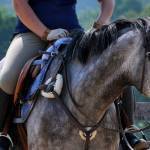Antioxidant Use in Equine Athletes with Muscle Fatigue, Damage

Horses possess undeniable athletic prowess, whether they race, leap, or pull. Even the fittest equine athletes tire eventually, though, and face muscle damage and antioxidant enzyme abnormalities.
“When horses become fatigued, they either continue to exercise at a lower intensity or stop exercising altogether. The reduction or cessation of exercise can result from both psychological and physiological factors,” advised Kathleen Crandell, Ph.D., a nutritionist for Kentucky Equine Research.
Psychological factors stem from the horse’s lack of motivation to continue, potentially secondary to overtraining. Physiological factors involve a variety of complex metabolic pathways in various body systems, not just the musculoskeletal system, such as metabolite production from muscle contraction and generation of excess heat in the muscle during exercise. In some cases, muscle fibers can be damaged with intense, prolonged work.
“Muscle damage is far more serious than simply muscle fatigue. Horses with fatigue can recover fairly quickly after exercise, whereas horses with muscle damage take longer to recover and mustn’t be rushed back,” Crandell said.
In their study involving six Arabian racehorses, Mami and colleagues evaluated various biochemical parameters to assess muscle fatigue and damage. All horses included in the study were fatigued at the end of their races and had altered antioxidant enzyme levels. Specifically, catalase and total antioxidant capacity were elevated immediately following the race but declined gradually thereafter. In terms of muscle function, aspartate aminotransferase (AST), lactate dehydrogenase (LDH), and creatine kinase (CK) were all elevated for the first hour after racing, but these values remained in normal ranges and were not suggestive of muscle damage.
“These results show that while the horses were tired and their antioxidant enzymes altered, no muscle damage occurred in concert with fatigue, suggesting that the studied horses were trained appropriately. If muscle damage had occurred, AST, LDH, and CK would have remained elevated following exercise,” explained Crandell.
In addition to appropriate training prior to competition, routinely supplement horses with a quality antioxidant product. Kentucky Equine Research offers Nano-E, a highly bioavailable, water-soluble form of vitamin E that enables administration to be timed perfectly to provide peak antioxidant protection to performance horses, as well as Nano-Q10, with coeznyme Q10 (ubiquinone), a powerful antioxidant that protects cells from damaging free radicals. Nano-Q10 also provides direct antioxidant protection and improves the antioxidant potential of other antioxidants in the body, like vitamin E.
You may also wish to explore the benefits of electrolyte supplements containing sodium, chloride, potassium, calcium, and magnesium.
*Mami, S., G. Khaje, A. Shahriari, et al. 2019. Evaluation of biological indicators of fatigue and muscle damage in Arabian horses after race. Journal of Equine Veterinary Science. 78:74-78.








